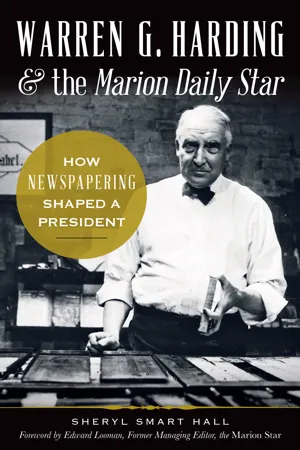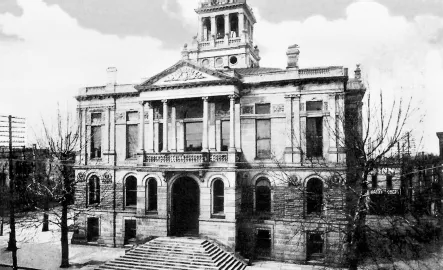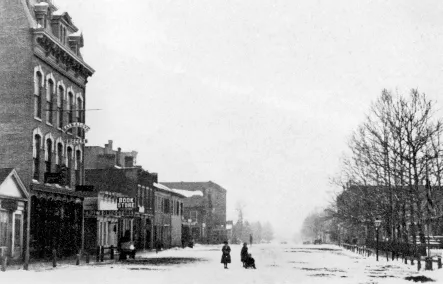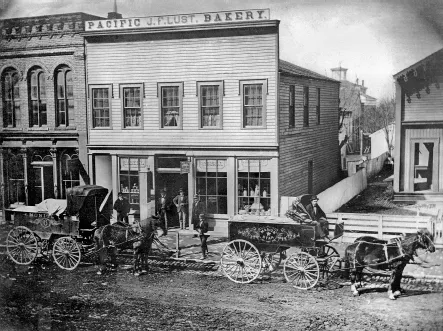
eBook - ePub
Warren G. Harding & the Marion Daily Star
How Newspapering Shaped a President
- 145 pages
- English
- ePUB (mobile friendly)
- Available on iOS & Android
eBook - ePub
About this book
How a committed journalist transformed a small town daily newspaper—and how that editorial success inspired his policies as President of the United States.
President Warren G. Harding's thirty-nine-year career as a newspaperman is often treated as a footnote. This book offers a unique approach to the Harding story, presenting him as he saw himself: as a newspaperman. His political successes were based on the thinking of a newspaper editor—balancing all of the facets of an issue, examining the facts and weighing the effect on the constituents. Even his approach to balancing the federal budget was built on early experience at his small, struggling newspaper, where his motto was: "All paid in, all paid out, books even." The only member of the Fourth Estate to enter the White House, Harding found his voice through the pages of the Marion Daily Star. Author Sheryl Smart Hall offers an intimate view of the man, often as seen through the eyes of those who knew him best—his co-workers at the Star.
Includes photos
President Warren G. Harding's thirty-nine-year career as a newspaperman is often treated as a footnote. This book offers a unique approach to the Harding story, presenting him as he saw himself: as a newspaperman. His political successes were based on the thinking of a newspaper editor—balancing all of the facets of an issue, examining the facts and weighing the effect on the constituents. Even his approach to balancing the federal budget was built on early experience at his small, struggling newspaper, where his motto was: "All paid in, all paid out, books even." The only member of the Fourth Estate to enter the White House, Harding found his voice through the pages of the Marion Daily Star. Author Sheryl Smart Hall offers an intimate view of the man, often as seen through the eyes of those who knew him best—his co-workers at the Star.
Includes photos
Frequently asked questions
Yes, you can cancel anytime from the Subscription tab in your account settings on the Perlego website. Your subscription will stay active until the end of your current billing period. Learn how to cancel your subscription.
At the moment all of our mobile-responsive ePub books are available to download via the app. Most of our PDFs are also available to download and we're working on making the final remaining ones downloadable now. Learn more here.
Perlego offers two plans: Essential and Complete
- Essential is ideal for learners and professionals who enjoy exploring a wide range of subjects. Access the Essential Library with 800,000+ trusted titles and best-sellers across business, personal growth, and the humanities. Includes unlimited reading time and Standard Read Aloud voice.
- Complete: Perfect for advanced learners and researchers needing full, unrestricted access. Unlock 1.4M+ books across hundreds of subjects, including academic and specialized titles. The Complete Plan also includes advanced features like Premium Read Aloud and Research Assistant.
We are an online textbook subscription service, where you can get access to an entire online library for less than the price of a single book per month. With over 1 million books across 1000+ topics, we’ve got you covered! Learn more here.
Look out for the read-aloud symbol on your next book to see if you can listen to it. The read-aloud tool reads text aloud for you, highlighting the text as it is being read. You can pause it, speed it up and slow it down. Learn more here.
Yes! You can use the Perlego app on both iOS or Android devices to read anytime, anywhere — even offline. Perfect for commutes or when you’re on the go.
Please note we cannot support devices running on iOS 13 and Android 7 or earlier. Learn more about using the app.
Please note we cannot support devices running on iOS 13 and Android 7 or earlier. Learn more about using the app.
Yes, you can access Warren G. Harding & the Marion Daily Star by Sheryl Smart Hall in PDF and/or ePUB format, as well as other popular books in Politics & International Relations & Journalist Biographies. We have over one million books available in our catalogue for you to explore.
Information
1
The Big Plunge
Warren Harding entered the world of newspaper ownership twice, both times with the same newspaper and both times in the same year.
In the summer of 1884, Warren heard that the Marion Daily Star was up for sheriff’s sale—again. Buyers were hard to find, as the Star’s record of failure was well known.
Unlike its nameplate, the Star was anything but a daily newspaper. It had been billed as a Monday-through-Saturday daily since its inception as the Marion Daily Pebble in 1877, but the truth was, it never achieved that status. It was available to Marionites twice a week, weekly or whenever the constantly changing string of owners could manage. During that messy history, two of its young owners, Willis and Harry Hume, brought their father, Sam, into the business and changed the name to the Star, perhaps hoping a new name would erase memories of the lackluster Pebble.
Convinced that journalism was his life’s calling—at least life as an eighteen-year-old envisioned it—Warren badgered his father to buy a half interest. Forty-four-year-old carpenter Benjamin Dempster already anchored the other half. George Tryon Harding needed little convincing to return a vacant lot to the bank for payment and assume half of the Star’s debts, which were then placed in Warren’s name.1
Just after the papers were signed, Warren hopped on a westbound train with the free rail passes he found in the back of a desk drawer at the Star office on North Main Street and traveled to Chicago as an observer at the Republican National Convention. That June, the Interstate Industrial Exposition Building brimmed with energy and excitement as a slate of Republicans, including President Chester Arthur, vied for the presidential nomination. Warren hoped to get a glimpse of his hero, James Blaine. Blaine had been secretary of state and valued advisor to President James Garfield—and was a former newspaper editor. A colorful and enthusiastic speaker, Blaine appealed to young men in Warren’s generation.
Blaine captured the nomination on the fourth ballot, and Harding returned to Marion flushed with happiness at being on the fringe of national politics. As the train cars swayed back and forth on their journey to Marion, Warren scribbled several pages of notes about his experiences, with his souvenir Blaine plug hat carefully placed on the seat beside him. Eager to get his words into print, he jumped off the train as soon as it pulled into town and ran nearly all the way to the Star office. He pulled up short at the top of the narrow stairway, finding a darkened office and a formidable-looking lock bolting the door. A hastily scribbled note from the sheriff was tacked on the door, stating that the bank had foreclosed on Doc Harding’s land used to secure Harding’s half ownership. He was out of the newspaper business before he had started.
“During my absence the sheriff found an extra Star on his hands,” Harding said with a chuckle years later.2
At the time, Warren did not find the event remotely funny. He was unemployed and broke—but he was not done with journalism.
He soon walked into the office of the Marion Democratic Mirror on the second floor of the Masonic Block on East Center Street looking for work, and publisher Jim Vaughn hired him on the spot. “The salary was seven dollars per week for writing editorials, meeting trains to secure ‘personals,’ hustling for advertisements, opening the office, scrubbing floors, setting type, making up forms, and even delivering some of the papers.”3
For several months, Warren’s job went smoothly, and he gained valuable insight about how a newspaper office functioned. He kept his opinions to himself and wrote the news. But then Vaughn gave him the assignment of writing an editorial severely critical of Blaine, and Warren embarked on a one-man protest. He wore his Blaine hat into the Mirror office. Vaughn asked him to remove it, Harding refused and the young man again was out of work.
Meanwhile, Dempster, who had continued to sporadically publish the Star, ran out of money. In November, the Star again was in its familiar place on the sheriff’s sale docket.
According to Jack Warwick, a native of Harding’s boyhood village of Caledonia, Ohio, Harding hatched the plan to buy the Star on election night 1884. That night, Democrat Grover Cleveland slipped by Blaine by thirty thousand votes for the presidency, much to Warren’s disappointment. In a final humiliation, the Citizens Band, in which founding member Harding played cornet, was hired to play at a celebration for the newly elected Cleveland. Warren, though, soon turned the dismal night on its head.
“The smelly torchlight procession came to an end and the exuberant marchers were crowding into the saloons to yell at the bartenders when Warren G. came along with his cornet under his arm,” Warwick said. “The country might be lost, but he still had his appetite. The three of us [Harding, Warwick and John Sickel] went into William Meily’s restaurant on Main Street and consumed oysters. It was here that Harding proposed to me that we buy the Marion Daily Star. Sickel suggested we make it go three ways.”4
Harding’s business proposal, seemingly spontaneous, really had been banging around in his head since the Star slipped out of his grasp the first time. He now realized that he had only been going through the motions during previous attempts at other professions.
For two years, since graduating from tiny Ohio Central College at age seventeen, Harding had been casting about aimlessly for a profession that stirred passion in him. He taught in a one-room schoolhouse north of Marion for a year and hated every minute of it. He was moderately successful at selling insurance and tried to get excited about the idea of studying law as his father wished. Nothing clicked. Only the pungent odor of printer’s ink and the feel of soft, white newsprint made his blood race.
To Warren, the chance to buy the Star again seemed like destiny. The purchase price amounted to $300 or $450, depending on who was doing the talking and when. Harding himself gave the two amounts at different times. The Star’s 1895 Industrial Edition, which summed up the progress of the city, listed the paper’s original purchase at $450.5 During Harding’s 1920 presidential campaign, he said the amount was $300.6
Various accounts also exist about whose money was used to purchase Harding’s share of the Star. The most likely story is that Harding’s father loaned Warren the money. Others say Harding’s former boss, Jim Vaughn of the Mirror, gave him the money, apparently confident that the competing Star would go down in flames for the final time. Harding himself hinted that he used his savings, but he never really bothered to clear up the story.
Marion marked its sixty-second year of existence in 1884. The few remaining pioneers were feeble now, and the elite of the second generation of Marionites ran the city of nearly four thousand people. Most of these men were in their forties and fifties, and many had fought for the Union in the Civil War. They were men who financed the building of Marion’s commercial district, organized its banks and major businesses, sought the railroad lines to serve it and propped it up when times were lean. They also made their money from Marion as it grew from infant to toddler.

As Marion’s new courthouse took shape in 1884, Warren and Jack Warwick struggled to keep the Star afloat. The courthouse featured “imported” sandstone from northern Ohio and a red-painted dome. Inside, grand staircases pulled attention up to the murals painted on the ceilings. Courtesy of Randy and Sandy Winland.
This group, called the “old guard” by Warren’s twenty-something friends, included such men as Amos Kling, Harry True, Henry Hane, C.C. Fisher, inventor Edward Huber, J.S. Reed, Edward Durfee, George Christian Sr., Tim Fahey, Henry Barnhart, attorney Samuel Bartram and William Fies.
Many of them had pushed for the building of a new Marion County Courthouse, now under construction at the heart of the town—Center and Main streets. Like most Ohioans, Marionites considered a regal courthouse to be a mark of legitimacy. This courthouse called for “importing” sandstone from Amherst in northern Ohio and would also include intricate carvings of pioneer faces on the outside and majestic, painted murals in the interior.7
When Harding assumed the helm of the Star, Marion boasted twenty-two streets—all emanating from the courthouse in a grid pattern. The commercial district stretched roughly two blocks north and south on Main Street and about three blocks east and west on Center Street.

When Warren arrived in Marion in 1882, the village seemed like a metropolis to him. This view shows Center Street on a winter’s day. The courthouse is out of view on the right. Courtesy of Randy and Sandy Winland.
The compact business district included three- and four-story brick buildings, housing ground-floor businesses such as Strelitz and Son clothiers, W.A. Turney’s jewelry store, Harry Weaver’s restaurant and Tim Kelly’s wholesale liquors on North Main Street. Henry Ackerman’s piano store, Fred Diebold’s restaurant and Felty & Son meat market anchored South Main. The buildings’ second and third floors were occupied by attorneys, doctors, dentists and insurance agents.8
Three depots served the rail lines that converged on West Center Street, a most inefficient setup about which the citizens routinely complained. Already, talk centered on how to bring the railroad brass together and have them build a “union” depot.
Fine brick houses from Civil War days and earlier dotted the Marion landscape, such as Henry True’s home at the corner of South (Church) and East (State) streets, Judge Ozias Bowen’s towering residence near Gospel Hill and the elegant stone house at the corner of Center and West (Prospect) streets owned by the revered Dr. Robert Sweeney. The newer houses were a mix of imposing brick or stone residences and stately wooden Victorian ones, complete with stained-glass windows and elegant turrets.
Warwick, Sickel and Harding—composing the Star Publishing Company—moved into the Star’s existing office rooms on the second floor of the Miller Block in downtown Marion, the same rooms Warren had barely glimpsed several months earlier. Marionites in those days referred to business locations by the “block” they were in rather than by the address or street name. “Block” normally did not mean a true city block; rather, it referred to one building usually carrying the investor’s name. The Miller Block was on the east side of North Main Street, adjacent to North Street. Most folks called North Street “Railroad Street” for the obvious reason that it followed the east–west railroad tracks cutting through Marion.
The Star offices consisted of two small rooms, one facing the street and one directly across the hallway facing the rear of the building. The rear room had an old, black, hand-operated Fairhaven press, enough body type to produce one issue of the paper at a time, some job type and advertising type.9
“There never was a place more generally and particularly unfitted, in all its appointments, for a newspaper office than this second floor front and back which we occupied immediately following the adoption of the sick kitten,” Warwick lamented, using the “sick kitten” label that he and Harding had given the new endeavor. “Upended, the room in which we worked would have been no taller than the small boy’s conception of Alexander the Great. It was long and lean and sepulchral.”10
From the start, Harding was the front man—the face of the Marion Daily Star. He certainly looked the part: six feet tall and slender, with extremely handsome features that people described as Roman. His black hair, gray eyes and dark moustache completed the package. He usually wore a long frock coat in the style of the day. He was charged with gathering the odds and ends of news and spreading the goodwill of the Star. That goodwill, he hoped, would translate into a bounty of advertising revenue.
Warwick, at twenty-three, was the eldest statesman of the trio and anchored the mechanical side of the operation. He had worked as an apprentice printer as a teen at the Caledonia Argus and most recently in Kansas, so he had a good working knowledge of the machinery. Twenty-year-old Sickel was the silent investor who naïvely jumped into the project when he had an inheritance burning a hole in his pocket and thought the newspaper business would be fun. He had no knowledge of newspapering and little interest in it. Warwick talked Sickel into learning how to set type, but the venture was short-lived. He gave up in a week or two, Warwick said, “not in despair but for fresh air.”11 Journeyman typesetter Claude Drake and a printer’s devil completed the staff. Printer’s devil was newspaper industry slang for an apprentice who was in the early stages of learning to set type and run a press.

A Star delivery wagon makes a stop in front of Lust’s Bakery on North Main Street in the 1880s. The wagon most likely was part of Sam Hume’s Star operation prior to Harding’s purchase of the paper in 1884. Courtesy of Randy and Sandy Winland.
Warren’s corner in the front room wa...
Table of contents
- Front Cover
- Half Title
- Title Page
- Copyright
- Dedication
- Contents
- Foreword
- Prologue
- 1. The Big Plunge
- 2. The Shaky Start
- 3. The Nemesis
- 4. The Star Inches Forward
- 5. “Booming” Marion
- 6. The Man Behind the Pencil
- 7. The “Human” Editor
- 8. A New Partner
- 9. The Call of Politics
- 10. The Other Woman
- 11. The National Stage
- 12. Marion Plays Host to America
- 13. Editor in Chief
- 14. -30-
- Epilogue
- Notes
- Bibliography
- About the Author